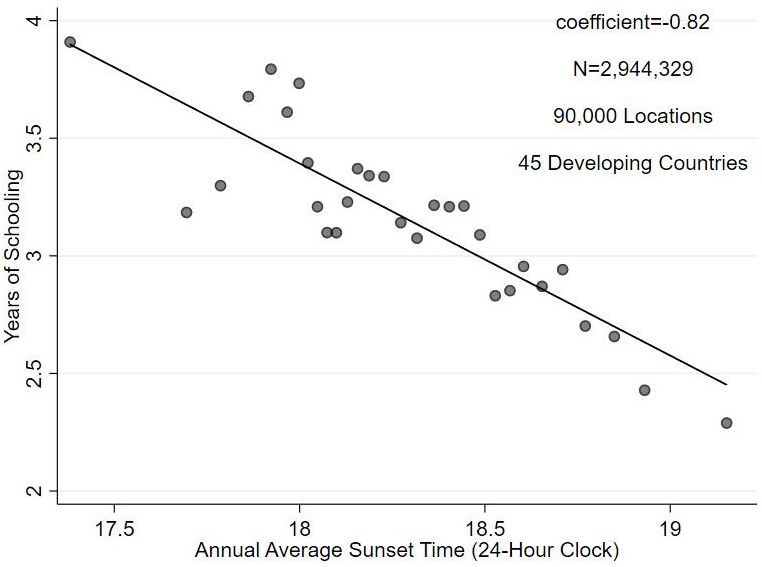Emerging out of the British Empire in the mid-20th century, India reckoned a single time zone would serve as a unifying force, and adopted the Indian Standard Time across her territorial boundaries. However, India spans roughly 30° longitude, corresponding with a two-hour difference in average solar time from east to west. This article provides evidence that arbitrary clock conventions – by generating long-term differences in sleep – influence the geographic distribution of educational attainment levels.
Each evening the sun sets more than 90 minutes later in west India than in the east of the country. This is because time on clocks across India is set to Indian Standard Time, regardless of location. In China all clocks are set to Beijing Time, which means in western part of the country the sun sets three hours later than the east of the country. The sun sets at least an hour later in Madrid than in Munich because Franco’s Spain switched clocks ahead one hour to be in sync with Nazi Germany in 1940, even though Spain is geographically in line with Britain, not Germany. Similarly, for a range of historical reasons, clocks in large parts of the planet – for example, France, Algeria, Senegal, South Sudan, Russia, and Argentina – are set to be ahead of their (solar) time. Therefore, these places see the sun set later in the day. In my job market paper (Jagnani 2019), I provide the first evidence that these arbitrary clock conventions – by generating large discrepancies in when the sun sets across locations – help determine the geographic distribution of educational attainment levels.
Figure 1. Annual average sunset time and years of schooling for 6-16 year olds across the developing world

School-age children in locations that experience later sunsets attain fewer years of education due to the negative relationship between sunset time and sleep, and the consequent productivity impacts of sleep deprivation. The non-poor adjust their sleep schedules when the sun sets later; sunset-induced sleep deficits are most pronounced among the poor, especially in periods when households face severe financial constraints. Because education is both a driver of economic growth and a means to reduce income inequality (Barro 2001), these results imply sunset time associated with geographic location may contribute to persistent poverty and worsening inequality.
Sunset time, sleep, and education production
As the sun sets and the sky grows darker, the human brain releases melatonin, a hormone that facilitates sleep (Roenneberg and Merrow 2007). Yet social norms or policy choices at the federal or state level – for example, start times for school and work – may dictate wake-up times that do not co-vary with sunset time (Hamermesh et al. 2008). As a result, children sleep less in locations exposed to later sunsets. If sleep is productivity-enhancing (Lim and Dinges 2010), later sunset may directly, adversely, affect children's learning.
However, the consequent effect of later sunsets on educational attainment is ambiguous; how children trade-off sleep with other time uses may have multiplicative or compensatory effects on education production. If sleep makes study effort more productive, later sunset may not only reduce sleep but also make studying less effective, decreasing study time. Conversely, later sunset (more daylight after school) might make it easier for children to self-study in the evening, especially in lower income countries where electricity access is intermittent. Moreover, child labour is common in lower income countries. Therefore, any complementarities between sleep and study effort may also depend on the marginal increase in children's labour productivity with respect to sleep.
Children exposed to later sunset sleep less, study less, and attain fewer years of schooling
I use the 1998-99 Indian Time Use Survey (ITUS) to evaluate the effect of later sunset on children's time use (Jagnani 2019). ITUS provides 24-hour time use data, collected with less than a 24-hour recall lapse, allowing me to assign each observation a district-date sunset time. My baseline econometric specification exploits seasonal variation in daily sunset time at the district level, after controlling for fixed district-specific characteristics as well as seasonal confounders common across all districts in the sample.
I show that an hour (approximately two standard deviations)1 delay in sunset time reduces children's sleep by roughly 30 minutes: when the sun sets later, children go to bed later; by contrast, wake-up times are not regulated by solar cues. Sleep-deprived children decrease productive effort: later sunset reduces students' time spent on homework or studying, as well as child labourers’ time spent on formal and informal work, while increasing time spent on indoor leisure for all children. This result is consistent with a model where sleep is productivity-enhancing and increases the marginal returns of study effort for students and work effort for child labourers.
Next, I examine the consequent 'lifetime' or long-run impacts of later sunset on stock indicators of children's academic outcomes. I use nationally-representative data from the 2015 India Demographic and Health Survey (DHS) to estimate how children's education outcomes co-vary with annual average sunset time across eastern and western locations within a district. I find that an hour (approximately two standard deviations) delay in annual average sunset time reduces years of education by 0.8 years, and children exposed to later sunsets are roughly 25% less likely to complete primary and middle school. I show that an hour delay in annual average sunset time also reduces school enrolment by 20%, and decreases math test scores by 0.6 standard deviations.
Generalisability?
To argue that these results are generalisable, I use data from China and Indonesia. Unlike ITUS, the 2004-2009 China Health and Nutrition Survey collects data on children's time use for a ‘typical’ day of the year, and not for a particular date. I use cross-sectional2 variation in annual average sunset time across districts within a state. In line with my India estimates, an hour delay in annual average sunset time reduces children's sleep by roughly 30 minutes. To corroborate the effects of later sunset on children's academic outcomes, I use the 2003 Indonesia DHS, employing a sharp regression discontinuity design3 that exploits time zone boundaries in Kalimantan, Indonesia. I find that an hour delay in annual average sunset time reduces years of schooling by 0.7 years, quite similar to my India estimate.
Poverty helps explain why families fail to adjust their sleep schedules on later sunset days
The timing of natural light is determined by time zones and is therefore predictable across locations and seasons. If sleep is important for productivity, why don’t households adjust their sleep schedules in response to later sunset, or simply get on a consistent sleep schedule regardless of sunset time, minimising the resulting human capital impacts? Do financial or psychological considerations associated with poverty help explain why families fail to adjust their sleep schedules when the sun sets later?
To test this hypothesis, I examine heterogeneous (diverse) impacts of later sunset on sleep by correlates of poverty (example, education, average monthly expenditure) in India. The negative effect of later sunset on sleep is at least 25% larger among low socioeconomic status (SES) households compared to high SES households.
To evaluate whether this heterogeneity truly reflects the influence of poverty, I restrict the sample to crop cultivator households, and exploit quasi-experimental variation in wealth around the harvest period, comparing the effect of later sunset on sleep in the month before harvest, when crop cultivator households are poorer and typically liquidity constrained, with the month after harvest, when richer and more financially liquid. Because harvest calendars vary across seasons and locations, I also control for all fixed differences between time periods and districts. For individuals with formal morning start time constraints – school-age children from crop cultivator households – pre-harvest poverty explains about a quarter of the effect of later sunset on sleep. But for individuals that don't have formal work start time constraints – adults from crop cultivator households – the entire effect of later sunset on sleep is driven by the period when the household is poor (pre-harvest).
Policy options: Time zones, later school start times, and social protection programmes
Back of the envelope estimates suggest that India would accrue annual human capital gains of over US$4.2 billion (0.2% of GDP (gross domestic product)) if it switches from the existing time zone policy to the proposed two time zone policy: UTC+5 (Universal Time Coordinated) for western India and UTC+6 for eastern India, where western (eastern) India includes districts to the left (right) of 82.5°E, and the meridian passing through 75°E (90°E) defined as its central meridian.
However, there may be benefits associated with the synchronisation of daily schedules across the country (Stein and Daude 2007), and one must be cautious about proposing changes to the existing time zone policy without a thorough cost-benefit analysis. Therefore, I also explore two other policy interventions that may mitigate the effects of later sunset on children's education outcomes: (i) later school start times, and (ii) social protection programmes. I find suggestive evidence that later school start times allow children to compensate for later bedtimes by waking up later and attenuate the effect of later sunset on schooling outcomes. Meanwhile, each additional year of exposure to a conditional cash transfer programme, MNREGA4 (Mahatma Gandhi National Rural Employment Guarantee Act), mitigates the effect of later sunset on children's test scores by roughly 5%.
This article first appeared on the World Bank Blog: https://blogs.worldbank.org/impactevaluations/here-comes-sunset-it-puts-children-sleep-and-affects-global-educational-outcomes
Notes:
- Standard deviation is a measure that is used to quantify the amount of variation or dispersion of a set of values from the mean value (average) of that set.
- Cross-section refers to data at a specific point in time.
- Regression discontinuity design is a technique used to estimate the effect of an intervention when the potential beneficiaries can be ordered along a cut-off point. The beneficiaries just above the cut-off point are very similar to those just below the cut off. The outcomes are then compared for units just above and below the cut off to estimate the treatment effect.
- MNREGA guarantees 100 days of wage-employment in a year to a rural household whose adult members are willing to do unskilled manual work at state-level statutory minimum wages.
Further Reading
- Barro, Robert J (2001), “Human Capital and Growth”, American Economic Review, 91(2): 12-17.
- Hamermesh, Daniel S, Caitlin Knowles Myers and Mark L Pocock (2008), “Cues for Timing and Coordination: Latitude, Letterman, and Longitude”, Journal of Labor Economics, 26(2).
- Jagnani, M (2019), ‘Poor Sleep: Sunset Time and Human Capital Production’, Job Market Paper.
- Lim, Julian and David F Dinges (2010), “A Meta-Analysis of the Impact of Short-Term Sleep Deprivation on Cognitive Variables”, Psychological Bulletin, 136(3): 375-389. Available here.
- Roenneberg, T and M Merrow (2007), “Entrainment of the Human Circadian Clock”, Cold Spring Harbor Symposia on Quantitative Biology, 72:293-9. Available here.
- Stein, Ernesto and Christian Daude (2007), “Longitude matters: Time zones and the location of foreign direct investment”, Journal of International Economics, 71(1): 96-112.




 16 January, 2019
16 January, 2019 




Comments will be held for moderation. Your contact information will not be made public.